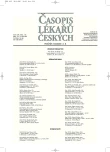Surgery Tracheostomies and Percutaneous Dilatation Tracheostomies – Retrospective Study
Authors:
J. Vodička 1; K. Pokorný 1; Petr Matoušek 2; D. Dejdar 3; J. Chalupa 4
Authors‘ workplace:
Klinika otorinolaryngologie a chirurgie hlavy a krku, Krajská nemocnice Pardubice
1; ORL oddělení, Nemocnice ve Frýdku–Místku
2; Chirurgická klinika, Krajská nemocnice Pardubice
3; Oddělení anesteziologie a resuscitace, Nemocnice ve Frýdku–Místku
4
Published in:
Čas. Lék. čes. 2007; 146: 546-550
Category:
Original Article
Overview
Background.
Surgical tracheostomy (ST) is replaced by percutaneous dilatation tracheostomy (PDT), namely because the second one requires less equipment and it consumes less time. PDT is indicated and performed mostly in intensive-care units. We focused on the type of technique of both methods and on the frequency of their complications.
Methods and Results.
Retrospective study of patients, who underwent tracheostomy in Hospital Pardubice and Hospital Frydek-Mistek from 1998 to 2002, was conducted. Total number of 667 tracheostomies was performed, including 561 (84 %) surgical tracheostomies and 106 (16 %) percutaneous dilatational tracheostomies. During the previous five years an increase of PDT was observed. For the surgical tracheostomy a horizontal incision of the skin at the throat (49 %) and the division of the thyroid isthmus (60 %) were performed most frequently. The skin at the throat was sutured to the tracheal mucosa to create a mucocutaneous anastomosis in 122 cases (22 %). PDT was performed using Griggs’ guide wire dilating forceps in all cases. Early postoperative complications were observed in 27 cases (5 %) in ST group and 12 cases (11 %) in PDT group. There were 50 cases (9 %) of late postoperative complications in ST group and 11 cases (10 %) of late complications in PDT group. Statistically significant difference was found only in early complications, which were more frequent in PDT group (p<0.05).
Conclusions.
During the last five years an increase of PDT performed to secure airways was observed. When performing ST, horizontal incision of the skin and division of the thyroid gland isthmus were used most frequently. Griggs’ technique was used to perform PDT. PDT was associated with the higher rate of early complications and there was no significant difference in late complications in both groups.
Key words:
tracheostomy, surgical tracheostomy, percutaneous dilatation tracheostomy, technique.
Labels
Addictology Allergology and clinical immunology Angiology Audiology Clinical biochemistry Dermatology & STDs Paediatric gastroenterology Paediatric surgery Paediatric cardiology Paediatric neurology Paediatric ENT Paediatric psychiatry Paediatric rheumatology Diabetology Pharmacy Vascular surgery Pain management Dental HygienistArticle was published in
Journal of Czech Physicians

Most read in this issue
- Surgery Tracheostomies and Percutaneous Dilatation Tracheostomies – Retrospective Study
- Juvenile Hyperbilirubinaemia and Its Early Manifestation in Adolescence
- Can Modern Infusion Solutions Cause Serious Disruption of Inner Environment of an Organism?
- Abdominal Tuberculosis in CT Imaging
